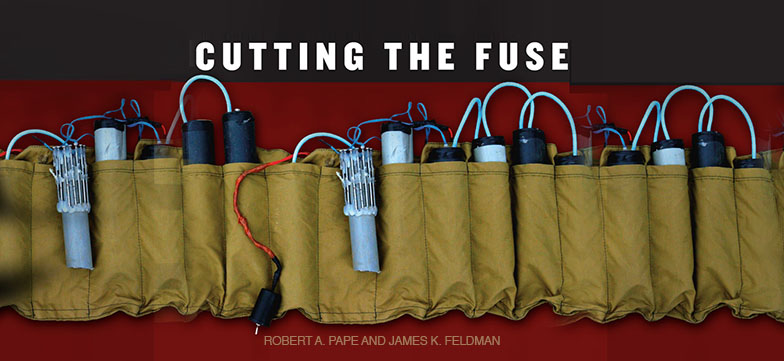It is that time of year again! The school semester has come to an end, work responsibilities are dwindling, and many of us will be spending more and more time aboard planes, trains, and automobiles. It’s time to slow down, enjoy the company of loved ones, and cuddle up with a good book.
You’re in luck! Our stellar interns have spent some time reviewing some interesting and extremely relevant books to complement your holiday season.
First up…
Cutting the Fuse: The Explosion of Global Suicide Terrorism & How to Stop It, by Robert A. Pape and James K. Feldman
By: Kathleen Ferraro, Communications Intern
Cutting the Fuse: The Explosion of Global Suicide Terrorism & How to Stop It, by Robert A. Pape and James K. Feldman, is an informative and readable analysis about the factors contributing to the post-9/11 increase in global suicide terrorism. Pape and Feldman open with an explanation as to why they focus solely on suicide terrorism, describing how one definitive instance of suicide terrorism–9/11–brought the idea of terrorism to the forefront of peoples’ minds. Furthermore, 9/11 changed the landscape of global terrorism by highlighting that retaliation would do nothing to deter a group of terrorists willing to give their lives.
The authors then move on to an analytical overview, investigating the chief cause of suicide terrorism, the formation of a suicide terrorist and the most effective counterterrorism strategies. They conclude that the main cause of suicide terrorism is resistance to foreign occupation, as motivated by the fear of oppression at the hands of foreign occupiers. This contention dispels the stereotype that all terrorists are Islamic fundamentalists with a religious agenda. The authors go even further, explaining that suicide terrorism is not an Islamic fundamentalist pattern. After all, there are plenty of Islamic fundamentalists who are not threatened by American occupation who do not become suicide terrorists–it is only the ones who are threatened by foreign occupation who act.
Pape and Feldman outline the typical formation of suicide terrorists, emphasizing that the motivating factor is typically primary group cohesion. This strong attachment to a kindred group unites potential terrorists and forms small group cohesion. In the case that this group decides to take jihadist action, the group typically socially withdraws and begins designing concrete plans for terrorism.
With these primary motivation and group formation concepts in mind, Pape and Feldman suggest that counterterrorism operations should focus on what makes these rare suicide attacks dangerous–that is, the point at which potential terrorist groups seek information and resources for lethal action. Searching for this pinpoints potential terrorist activity, rather than simply profiling Muslims with religious attachments.
To support their analytical framework, the authors outline the largest suicide terrorist campaigns the world has seen. Among the groups mentioned are Iraqi insurgent groups, Afghanistan’s Taliban and Al Qaeda, Lebanon’s Hezbollah, Palestinian resistance groups, Chechen separatists and Sri Lanka’s LTTE. They focus on how in each case, foreign occupation has been the principal trigger for suicide terrorism campaigns. They also provide evidence to the fact that religious difference between the foreign occupier and the occupied is a key enabling factor that explains why some occupations lead to suicide campaigns, and foreign occupation of kindred communities is the principal factor driving transnational suicide terrorism.
Finally, Pape and Feldman conclude their book with suggestions on how America should proceed in regards to suicide terrorism.
Cutting the Fuse presents a relevant and extraordinarily significant argument as to the causes and potential solutions for the global explosion of suicide terrorism. Though their analysis is jam-packed with data, complex sociopolitical dynamics, and transnational historical accounts, they present their main points in a clear and persuasive manner. Overall, Cutting the Fuse is an excellent liaison from expert to amateur, elucidating the complicated dynamics of suicide terrorism so that readers comprehend the gravity of the book’s contents in the real world.
Stay tuned for more reviews!

